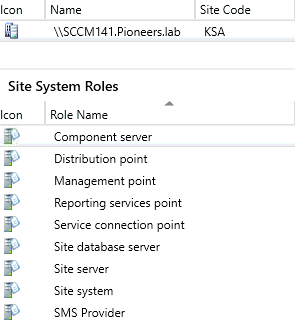Introduction
in previous two articles : we have discussed SCCM features and release history
and said that :
- SCCM or System Center Configuration Manager (ConfigMgr for short) is designed to help you manage the PCs and devices in your environment.
- Its purpose is to give your devices a source of configuration so as to standardize your systems across your domain no matter how large or small, no matter how complex.
also we mentioned that the most IT team who get benefit of SCCM is IT Help Desk
in this last articles of SCCM introduction : we will talk about SCCM Roles and Hierarchy
SCCM Hierarchy
SCCM Hierarchy could be ;
Central administration site :
- just to manage child sites , and could have up to 25Primary site
Primary Site :
- could have 250 Secondary site for each ,
- please note that is we installed primary standalone then it will NOT be able to join central administrative site later
Secondary site :
- mainly used if client computer more than 100,000 , or WAN traffic is Very Slow so
- we create secondary site to manage all client within branch physical site as secondary ,
- please note that secondary site doesn’t have administration console but could be managed by primary site console , also please note
- secondary site could be created only from [primary site console ] , NOT from installation Media
title
Site Server Role :
- first server that run Main SCCM functionality called [site Server ] which mainly responsible for 4 Asset Management features [HW inventory, SW inventory , Asset Intelligence , SW Metering ]and also to create [policy ]
Site Database Server :
- [SQL server ] please note client send and retrieve information from DB server using [Management Point role ]
Management Point [MP]role :
- run many features like : [client installation folder , Primary contact with client(SPOC) , send policy to client agent ,
Distribution Point [DP]:
- used mainly for three Library deployment [OSD , Application ,Update]
Application Catalog Website Point :
- client user side open [Software Center] application to browse application using [Application Catalog Website Point]
- Application Catalog Website Point send application to client side as [required ,which auto install application on client side ] or [available , which allow client user to install or NOT install application from web catalog ]
Application Catalog Web Services Point :
- used by server to show available services to client side , please note both [Application Catalog Website Point] and [Application Catalog Web Services Point] are integrated with each other
Asset Intelligence Synch Point :
- retrieve extra Software information from client side Like license
endpoint Protection Point :
- anti malware
Fallback status Point :
- client send error information if Management point MP is unavailable as alternative during either [client installation or client operation ], and used for troubleshooting
Enrollment Point :
- support mobile devices
Enrollment PROXY Point :
- manage secured communication channel with mobile devices [using HTTPS certificate ]
Out of Band Point :
- Manage off line devices using [wake on LAN feature ]
Reporting Services Point :
- to Run Reporting of SQL server [SRSS]
Software update Point :
- used by WSUS to deploy update to client side
System Health Validator Point :
- integrated with NAP for security purpose
[site Server ]
- communicate with [DB server ] using layer [SMS_Provider]
Management Point [MP ]
- Communicate with Client using either [HTTP] or [HTTPS]
Fallback status Point
- is NOT installed with default SCCM installation , so we have to install it manually before start install client agent
please note :
- Any SCCM site either [primary or secondary ] has site code [three alpha numeric ]
- Each Server Role should have agent enabled on client side , for example :HW inventory should be enabled on client side to send client HW details to server
- SCCM Policy work on schedule manner , but we can run policy manually on client side
you might find some difficulties to understand all concepts above :
don’t headache your self with that , all point will be fully covered and understood later when start practicing SCCM
just keep following networks pioneers
Conclusion
in three articles of SCCM introduction : we have got an overview about SCCM :
- the concept
- Features
- functionality
- release history
- Roles
- Hierarchy
this was the theoretical side of SCCM , and we tried in network pioneers to make briefly as much as possible ,
next article : we will discuss the SCCM prerequisites , installation , post installation >> as the first series of Practicing SCCM

